In the realm of AI language models, mastering the art of prompting is an essential skill. However, understanding the intricacies of crafting effective prompts can be challenging. This article, based on the below video from Jeff Su, aims to unravel the key components of a successful prompt, providing you with a formula that guarantees high-quality outputs consistently. Whether you’re delving into ChatGPT or exploring the realms of Google Bard, these principles will serve as your guiding light.
The Six Building Blocks of a Successful Prompt
- Task: The FoundationThe task is the cornerstone of your prompt. It outlines the action you want the AI to take, and it’s crucial to begin the task sentence with an action verb. Whether it’s generating, writing, analyzing, or any other directive, a clear task sets the stage for a meaningful interaction.
- Context: Setting the StageContext is the contextual backdrop against which the task unfolds. Providing relevant information about the user’s background, success criteria, and environment is essential. This step constrains the AI’s possibilities, allowing it to generate more pertinent responses.
- Exemplars: Elevating QualityExemplars, or examples, are powerful tools that significantly enhance the output quality. Incorporating relevant examples within your prompt, be it rewriting sentences, using structured frameworks, or referencing existing content, guides the AI toward producing more accurate and valuable responses.
- Persona: Shaping the InteractionThe persona component defines the character you want the AI to embody. Envision someone with the expertise or qualities that align with your task. Whether it’s a recruiter, a senior marketer, or even a fictional character, this persona provides a unique angle to the generated output.
- Format: Visualizing the OutputVisualization is key to crafting precise prompts. Close your eyes and imagine the end result. Visualize the desired format—whether it’s bullet points, emails, paragraphs, code blocks, or more. This step aligns your expectations with the AI-generated output.
- Tone: Conveying EmotionTone plays a pivotal role in communication. Specify the desired tone—casual, formal, enthusiastic, or any other sentiment. If you’re uncertain about the precise wording, provide keywords that encapsulate the intended emotional tenor.
Crafting the Perfect Prompt: Putting It All Together
To illustrate the effectiveness of this comprehensive prompt-building approach, let’s construct a compelling example:
Prompt:
You are a senior product marketing manager at Apple Persona, and you have just unveiled the latest Apple product in collaboration with Tesla—the Apple car. You received 12,000 pre-orders, which is 200% higher than the target. Write an email to your boss, Tim Cook, sharing this positive news.
Task and Format:
The email should include:
- TL;DR (Too Long; Didn't Read) section
- Project background
- Business results section with quantifiable metrics
- A closing section thanking the product and engineering teams.
Tone:
Use clear and concise language, and write in a confident yet friendly tone.
Conclusion
Mastering prompting on platforms like ChatGPT and Google Bard is an indispensable skill in the age of AI-powered interactions. By understanding the six essential components—task, context, exemplars, persona, format, and tone—you can craft prompts that consistently yield high-quality outputs. Whether you’re a beginner seeking guidance or aiming to level up your prompting game, this guide equips you with a formula that ensures meaningful and valuable interactions.





Leave A Comment